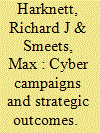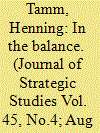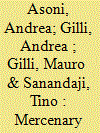| Srl | Item |
| 1 |
ID:
186097


|
|
|
|
|
| Summary/Abstract |
While much focus has remained on the concept of cyberwar, what we have been observing in actual cyber behaviour are campaigns comprised of linked cyber operations, with the specific objective of achieving strategic outcomes without the need of armed attack. These campaigns are not simply transitory clever tactics, but strategic in intent. This article examines strategic cyber competition and reveals how the adoption of a different construct can pivot both explanation and policy prescription. Strategy must be unshackled from the presumption that it deals only with the realm of coercion, militarised crisis, and war in cyberspace.
|
|
|
|
|
|
|
|
|
|
|
|
|
|
|
|
| 2 |
ID:
186100


|
|
|
|
|
| Summary/Abstract |
The two main rebel groups in the Second Congo War (1998–2003) evolved in remarkably different ways. While the MLC maintained organisational cohesion throughout the war, the RCD split into two rival groups within less than a year. The larger of these rivals then remained cohesive, whereas the smaller group experienced further fragmentation. This article draws on interviews with key protagonists to show that these cross-group differences resulted from different patterns of state sponsorship. Fragmentation occurred when the intra-group distribution of power between a rebel leader and an internal rival hung in the balance because external troops supported both sides.
|
|
|
|
|
|
|
|
|
|
|
|
|
|
|
|
| 3 |
ID:
186099


|
|
|
|
|
| Summary/Abstract |
Does wartime debate in democracies during counterinsurgency campaigns embolden insurgent adversaries? Despite the historical frequency of this claim, there is little direct evidence assessing this ‘emboldenment’ hypothesis. This paper develops a novel test of this argument during the US counterinsurgency campaign following the invasion of Iraq in 2003. We find that following spikes in US domestic debate over the Iraq war, there is no evidence that insurgent attacks on military or civilian targets increased in regions of Iraq with greater access to US news compared to regions with less access. Overall, these results offer no support for the emboldenment claim.
|
|
|
|
|
|
|
|
|
|
|
|
|
|
|
|
| 4 |
ID:
186098


|
|
|
|
|
| Summary/Abstract |
We test two sets of alternative hypotheses about the demographic composition of the U.S. armed forces. We analyse individual-level data of two national representative samples covering the period 1979–2008. We find that, in contrast to the accepted wisdom, the U.S. military no longer primarily recruits individuals from the most disadvantaged socio-economic backgrounds. Technological, tactical, operational and doctrinal changes have led to a change in the demand for personnel. As a result, on different metrics such as family income and family wealth as well as cognitive abilities, military personnel are on average like the average American citizen or slightly better.
|
|
|
|
|
|
|
|
|
|
|
|
|
|
|
|
| 5 |
ID:
186096


|
|
|
|
|
| Summary/Abstract |
Despite its prominence as a tool of statecraft, covert action’s defining characteristic – plausible deniability – remains a slippery concept. This article investigates the logics underlying the two main variants. The first ideal-type, the state model, captures efforts by states to disclaim sponsorship of covert operations. The drivers of covert action are primarily international, the sources of exposure are many, and its relationship with democratic norms is harmonious. The second ideal-type, the executive model, describes efforts to shield chief executives from blame. The drivers of covert action are domestic, the sources of exposure are limited, and its relationship with democracy is conflictual.
|
|
|
|
|
|
|
|
|
|
|
|
|
|
|
|